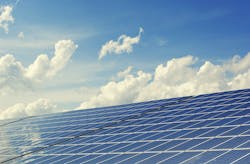A few years from now, if you’re at your home stadium dialing up an instant replay of the controversial penalty that the referee just infuriatingly called against your favorite kickass linebacker, the video clip could come to your phone via laser light.
That’s the vision of Kyocera SLD Laser. And it’s just one of many examples of how the company believes that laser chips, not LEDs, will finally help to usher in the Li-Fi era, in which modulated lightwaves will play a key role in delivering data and internet services, complementing and in some cases replacing the radiowaves of Wi-Fi.
As LEDs Magazine has been reporting, the ability of laser chips to operate at much higher speeds than LEDs could be the leap that Li-Fi technology needs to finally push it into commonplace use. To that end, at the 2022 CES consumer electronics show in Las Vegas, KSLD demonstrated a rudimentary laser Li-Fi setup operating at 100 Gbps, which is 100 times faster than any LED Li-Fi demo, and probably around 600 to 700 times faster than the fastest commercially deployed LED Li-Fi. LED system speeds in real-world deployments can often be not much faster than Wi-Fi.
While Santa Barbara, CA–based KSLD is a few years away from miniaturizing components for 100 Gbps, it does already offer a kit operating in the 1-to-2–Gbps range. Its Seattle-based partner Spectrum Networks is designing that gear into Li-Fi systems that will provide internet service and illumination to passengers on commercial planes. (Yes, lasers can be engineered for general illumination without causing eye damage).
One of the clear benefits that Li-Fi enthusiasts have long claimed over Wi-Fi is that Li-Fi does not interfere with radio equipment the way Wi-Fi can. In an avionics environment, that can be at least a perceived advantage, given all the recent discussion surrounding the deployment of radio-based cellular 5G services near airports.
A fast laser Li-Fi service makes that argument even more compelling.
Likewise, a fast laser-based service makes the noninterference case all the more engaging in other settings where Wi-Fi communications could disrupt operations of vital equipment, such as in hospitals, or on factory floors where electromagnetic robotic equipment might clash with the radio frequencies (RF) of Wi-Fi.
Radiowaves also pose another risk in that they leak outside of buildings where cyber intruders can hack them; light requires line of sight (so to speak, as some wavelengths would not be visible to human eyes).
“These sensitive applications where RF is really a challenge and you want to eliminate it is obviously the first place where it’s a no-brainer,” KSLD senior vice president of business development Paul Rudy told LEDs Magazine, when we asked him to elaborate on use cases.
In many ways, the intended use cases for Li-Fi have not changed since Harald Haas, then of the University of Edinburgh, led its invention over a decade ago while focused on the LED variety. Haas would go on to co-found Edinburgh-based pureLiFi, where he still serves as chief scientific officer. PureLiFi sells LED-based Li-Fi, although it has acknowledged that “laser light will better serve Li-Fi” and has started moving in that direction.
Haas, who wears many hats, is now also a senior advisor to KSLD while working as the distinguished professor of mobile communications at the University of Strathclyde in Glasgow, where he is also the director of the LiFi Research and Development Centre.
“The applications are the ones we’ve been saying for a long time,” Haas told LEDs.
And non-radio interference is one of those. Even the stadium example fits that category. As Haas explained, today’s stadium Wi-Fi transmitters are plagued by interference with each other. That, he said, is why installers often place transmitters under seats. Fans sitting on the seats act as radio shields — “attenuators” — minimizing interference for someone with a smartphone nearby. A light-based system would be far more effective, in KSLD’s view.
KSLD also sees laser Li-Fi playing a key role in in-car communications, car-to-car networking, and car-to-thing communications, especially as self-driving vehicles emerge. (It was no coincidence that at CES KSLD showed its 100-Gbps demo at the Auto hall).
In a similar vein, laser Li-Fi could become key to underwater communications, the company believes.
And then there is what Haas calls “one of my favorite topics” — giving solar panels the double duty of Li-Fi reception. Haas is trialing a system in Scotland’s Orkney Islands in which a lighthouse delivers modulated light to solar cells on panels that also provide electricity to nearby houses. The solar cells thus serve their conventional renewable energy purpose while also underpinning data communications.
“Solar panels are for me really a path toward net-zero, high-speed data communications,” Haas said.
And if you key on the “high speed” part, then LEDs have been just the warmup act. Lasers appear to be the main attraction in waiting.
MARK HALPER is a contributing editor for LEDs Magazine, and an energy, technology, and business journalist ([email protected]).
For up-to-the-minute LED and SSL updates, why not follow us on Twitter? You’ll find curated content and commentary, as well as information on industry events, webcasts, and surveys on our LinkedIn Company Page and our Facebook page.





